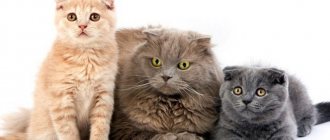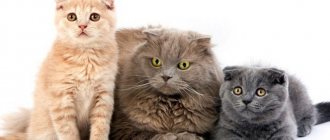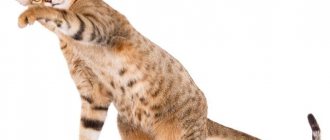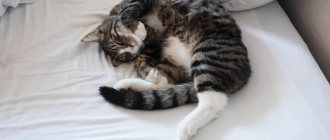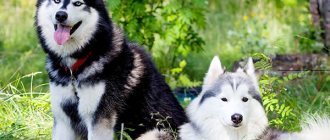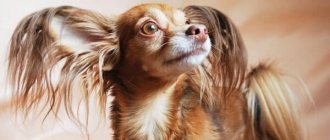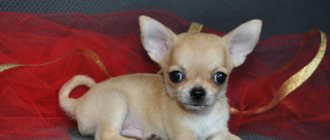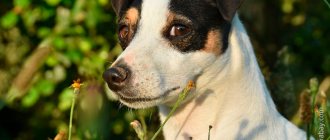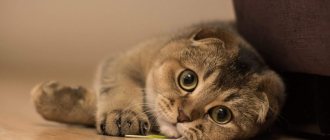Spotted color
The spotted color of the Bengal cat is the most popular color. If you have seen a Bengal cat, then most likely you have seen it in its spotted form. The brown spotted tabby color was recognized in Championship Status (TICA) in 1991.
Spotted Bengals have distinctive, small to medium-sized spots along the entire length of their body. Large, random, two-color rosettes are especially appreciated. This color in domestic cats looks like a mini-leopard. This style emerged when breeders believed that larger, sparser spots were more desirable. The original spotted tabby pattern found in domestic cats has been modified by selective breeding.
The coat is covered with random, diagonal or horizontally aligned spots on the body, belly and legs. Large dark spots on a light background are usually preferable.
Of course, there are variations in spotting, and one Bengal cat can have many different types of spots.
Single-Spotted
The spots are monochrome, one-color. These are simply solid spots splashed with droplets on a contrasting background, similar to wild cats such as Cheetahs or hybrid spotted cats (Ocicat, Egyptian Mau, Spotted Shorthair).
Bengals with solid spots are allowed to show, but are not preferred. Some breeders believe that they should not be allowed to compete.
The most popular spotted color for a Bengal cat is the Rosette Bengal. Spots are called rosettes when the spots are two-tone contrasting colors different from the background color. The Bengal cat is the only domestic cat with rosettes!
Rosettes in the Bengal breed began in the early 2000s, when some breeders bred the shade spots with darker spots. The rosette quickly developed.
When you see the evolution of the breed over the years, it is amazing to realize the progress that some rosette breeders have made in just a few decades.
The 3 most important types of socket:
— Arrows (Arrow-head) — Paw-print — Donut (Donut)
Arrowhead sockets
The arrows may be solid and monochrome in one spotted group, or they may be a variety of colors that fade toward the background. Well-defined arrow rosettes are rare and popular among Bengal cat owners and breeders.
The arrowhead socket is not the most common, but it is probably the easiest type of socket to identify. Arrow rosettes are shaped like a triangle, like the tip of an arrow or teardrop, with all ends pointing toward the back of the cat.
Asian leopard cats have many different color types, but the arrowhead pattern is one of the most visually impressive. Arrow-shaped spots are excellent camouflage in the dim light of a forest habitat. With such fur, a cat that stands motionless on trees or in fallen leaves is very difficult to notice.
The Bengal cat breed standard requires the spots to be horizontally aligned instead of the vertically aligned spots of the classic tabby. The arrow-shaped spots on the coat give them the appearance of illusory movement or motion blur.
Donut outlets
Donut rosettes are spots darker than the main background, outlined by an even darker outline.
The donut rosette gets its name from the almost complete dark outline around a lightly colored center.
It took years of selective breeding to create the donut-shaped rosettes, but they are now one of the most popular rosettes.
Paw-print rosettes
Paw print rosettes are shaded spots that are open on one side with smaller, darker spots on the edge. Such a rosette is never completely covered by a dark outline.
Footprint rosettes get their name because they often look like small paw prints running across a cat's body.
Smoked sockets
Smoke rosettes are large, full rosettes that seem to fit together like a puzzle with little space in between.
Chain socket
Chain rosettes are a linked series of donut rosettes connected horizontally and running parallel on either side of the cat's spine.
The chain rosette can also be seen on wild cats such as Ocelots.
Clusters of rosettes
Rosette clusters are small spots that form clusters around a central color.
Phasing in Bengal kittens
The spectacular color characteristic of Bengals does not appear immediately after birth. The pattern on a kitten's fur is unknown even at the time of moving to a new home. The babies are covered with thin hairs of a white, gray or red hue with a non-distinctive pattern. Up to a year, a Bengal cat can resemble a simple yard striper.
The phasing effect confuses buyers, because at the time of purchase the main qualities of the breed are hidden and you can only trust the reputation of the breeder.
The kitten's bright appearance is hidden due to phasing, which serves as a natural camouflage. The baby's coat begins to change at the age of 12-15 weeks, and ends no earlier than 7 months. The lighter the background of the coat, the sooner the camouflage disappears, while dark merle colors appear slowly. However, watching your pet grow brings pleasure, as the Bengal is transforming every day. By the age of 2, the beauty of a purebred Bengal cat is fully revealed.
Among the colors of the Bengal you can find both bright patterns and restrained tones. The diversity of the wild palette, combined with some unpredictability, makes the Bengal cat breed attractive to lovers of natural beauty.
join the discussion
Share with your friends
Bengals are one of those unique cat breeds that are considered highly sought after due to their distinctive and striking appearance and unique character traits. The breed first appeared in the States, where a wild Asian leopard cat was crossed with a regular short-haired cat. Europeans were able to see such a wild cat for the first time in the northeast of South Asia - in a historical region called Bengal, where the name of this magnificent breed came from.
The main difference that the modern breed has is the unique leopard pattern, which helps the color of the animals to be considered unique. Bengal cats received this kind of feature from their distant ancestors living in the wild. The coat of representatives of this breed has a very beautiful and even shine, which becomes especially noticeable in bright sunshine.
Marble color
The marbled pattern is formed from “liquid” spotted stripes swirling in a whirlwind. The ideal marbled Bengal cat has a horizontally flowing, random, asymmetrical structure consisting of swirls of two or more colors.
The marbled Bengal cat has four official types: reduced horizontal flow, horizontal flow, chaotic pattern and leaf marble patterns.
In 1987, Gene Mill (Millwood Cattery) released the first marbled Bengal kitten, a cat named Millwood Painted Desert:
She was an impressive little female with a strange, soft, creamy color and a strange pattern that looked like an ice cream caramel. At the Incats show at Madison Square Garden, and all over the country, she was a sensation!
In his first standard for the Bengal breed, Jean Mill did not intend to include anything other than spots. But Painted Desert was an instant success with both the judges and the public, and so the marble was included in the Bengal breed registry.
Descendants from these early marbled Bengals contributed to the description of the gene and horizontal flow that produced the first "rosette" spots in the 2000s.
In 1993, the merle color of the Bengal breed was included in championship status within the TICA.
Bonus: Marble Spot or Sparbl
)
Do you think that spotted and marbling patterns have never been seen before?
Look at the coloring where the spots and marbling merge. "Sparbling" is not actually an official color, but is used in the breeder's dictionary to describe Bengals that have both rosette and merle markings.
Sparble is considered a spotted Bengal cat, not a marbled cat.
Now that we have looked at the different patterns that Bengal cats have, let's look at the colors of the Bengal cat.
Like other cat breeds, Bengals come in a variety of colors. There are about 6 colors of the Bengal cat, divided into standard and non-standard by the International Cat Association (TICA).
Standard Bengal colors:
— brown (gold) — snowy — silver
Unrecognized colors:
— coal (charcoal) — blue — melanistic (black)
Yes, these are standard cat colors. But, of course, the complex beauty of the Bengal cat is not only 6 color options. No. The Bengal breed has many more colors and shades. But, regardless of color, the pattern on a Bengal cat should provide a high degree of contrast.
Description of the breed
The characteristics of the breed are described in standards approved in 1991. Depending on the weight and height of each individual, Bengals are simultaneously classified as medium and large breeds.
Sexual dimorphism is pronounced. Females have a more elongated and flexible body. The weight of cats varies from 4 to 5 kg. Males are larger, more muscular and more powerful. They can weigh between 6 and 7 kg. Height varies from 25 to 32 cm.
The head is medium in size. The transition from forehead to nose is slightly noticeable. The muzzle is wide. The eyes are oval shaped. All colors of the iris are acceptable, except aquamarine and blue (can only be in the snow color). The ears are medium in size, their tips are rounded.
The neck is powerful and long. The body is elongated, strong and muscular. The hind limbs are slightly longer than the forelimbs. The paws are round and powerful. The tail is not very long.
Bengals have a short, smooth coat with a distinct spotted pattern. There is almost no undercoat, so this breed is considered hypoallergenic. However, it is worth considering that often a person is allergic not to fur, but to the epithelium and saliva of the animal.
Allergy sufferers should consult a doctor before purchasing a Bengal.
The Bengal breed has one more feature that future owners need to know about. Kittens aged 3 weeks to 8 months cannot always boast of beautiful smooth fur and contrasting patterns. This is due to the protective mechanisms inherent in the wild ancestors of this breed. Asian wild cat kittens are overgrown with sparse light fluff, which hides their bright color. The kitten becomes less noticeable to the eyes of a predator. Over time, the fluff falls off, and in its place a beautiful, shiny coat appears. This phenomenon is called flazing.
It happens that the fluff does not fall off and remains with the cat for life. An animal with this feature is prohibited from being bred.
Glitter is another unusual phenomenon inherent in Bengals. The fur of some representatives of the breed literally reflects the rays and shimmers very beautifully in the sun. Unfortunately, this effect is not inherent in the fur of all Bengal cats.
Brown (golden) Bengal cat
The brown (or golden) Bengal (C,C color genes) is the most popular of the Bengal cats, and was the first cat to be recognized by TICA in 1983.
Traditional brown Bengals have green or gold eyes.
The background color can vary from a gray-brown tone to a bright orange-gold.
The color of the spots, rosettes, or marbles can range from black/light brown to darker or reddish brown.
If you have a brown furry friend, you probably know that brown comes in a variety of shades such as: gold, cream, dance, honey, taupe, dance, beige, caramel, cinnamon.
All shades of brown are acceptable, but orange-brown is preferred for the main background color of the coat.
As you can see, almost all shades of brown are available for the Bengal breed.
Now, if you look at a brown (golden) Bengal, you will notice the following characteristics:
- Brown tail with a black tip - Pink nose - Brown, copper, gold, green or brown eyes - White belly preferred
Magnificent creatures, aren't they?
Features of keeping Bengals
First of all, you need to keep in mind that Bengal cats do not tolerate loneliness well. And the best way to care for an animal is to constantly have someone from your family next to your Bengal.
Bengal cats are very active and inquisitive guys.
Other features of keeping these predators are:
- constant access to water, including running water (you can purchase a special fountain for this);
- regular hygiene procedures - cleaning ears and eyes with cotton swabs, combing the fur coat with a cat brush (especially during shedding);
- at the same time - rare bathing - no more than once every three months, so as not to spoil the structure of the coat and not dry out the delicate skin;
- providing a large space for the cat to live and play;
- regular walking in the fresh air;
- weekly nail trimming using a special nail clipper;
- The installation of a columnar scratching post with high stability is also required.
Owners of Bengal cats also note the animals' love for window openings, so it is important to ensure the safety of such places in the house. The safest thing to do is to put limiters on each window.
As for the toilet, it is important to remember that domestic leopards have a penchant for burying. Therefore, when choosing a tray, it is better to give preference to deep or closed models. Both regular sand and classic mixtures for cat litter are suitable as filler. The volume of filling the tray is also important - the more mixture, the better for a clean pet.
You need to choose a place for the toilet in advance, and the best option would be a secluded and at the same time accessible corner for the cat.
If an animal refuses to go to the litter box, there is no need to scold or punish the Bengal for this. Otherwise the problem will only get worse. The reason for this behavior may be a disease of the genitourinary tract, or the smell of the fragrance used to treat cat litter.
Regarding the feeding regime, the following points should be noted:
- adults are fed twice a day, adolescents (up to six months) three times, and kittens - four;
- The Bengal menu should consist of 60% meat, 20% grain, and 20% vegetable;
- for the first feeding at the age of six weeks, finely chopped chicken meat, scalded with boiling water, is suitable;
- further, other types of meat, cereals and raw eggs are introduced into the diet;
- adults need to eat well, and the food must be fresh and of high quality;
- you should not give cats milk, replacing the latter with plain yoghurts and yogurt;
- Fish should be given rarely so as not to provoke urolithiasis.
If the animal eats dry food, it is necessary to ensure that the Bengal has constant access to water.
To maintain health, it is recommended to include vitamin and mineral complexes with calcium and glucosamine in your cat’s diet.
In addition to milk, the following types of products are prohibited for Bengal cats:
- chicken and fish bones;
- meat of pig, goose, lamb and turkey;
- sausages and canned products;
- smoked and spicy dishes;
- confectionery and sugar;
- potatoes and beans.
It is also important to monitor the temperature of the food, because too cold or hot food can damage the integrity of tooth enamel, and the animal can catch a cold or get a burn in the mouth.
Snow Bengal cat
Looking for Mini Bars? Then this is the cat you are looking for.
Unlike the name, they are not completely white Bengal cats.
In fact, the Snow Bengal color comes in 3 genetically different colors (and names):
— Snowy Sepia — Snowy Lynx — Snowy Mink
It can be difficult to tell the difference between these three colors. A genetic test is always the best method for differentiating the 3 snow bengals. Alternatively, eye color can help determine the Bengal's snow color.
Snow Lynx (color genes Cs, Cs) has:
- Very light white cream color - Dark or light markings - Dark tail tip - Blue eyes. Always.
Snow Mink (color genes Cb, Cs) has:
- Ivory, cream, light-tan - Various shades of markings from light beige to dark beige or coffee - Dark tail tip - Blue-green or aquamarine eyes
Snow Sepia (color genes Cb, Cb) has:
- Ivory, cream, light-tan - Various shades of markings from light coffee to dark - Dark tail tip - Green or gold eyes
Not so bad, right? Isn't it too difficult now to determine which Bengal color you want?
Silver Bengal cat
Silver (I,I inhibitory genes) is more of a color deficiency. This gene blocks any warm colors and produces an almost white background that contrasts with the bright dark markings. Silver color was added to the TICA Championship in 2004 for the Bengal breed.
Silver Bengal cats come in a variety of shades with backgrounds ranging from white to a very dark, steely color.
Silver can also be found in any other color combination: Snow Silver, Charcoal on Silver, Blue Silver, etc.
Silver Bengal has:
- As little yellow and brown as possible in color - Dark gray to black markings - Black tip of tail - Brick red nose - Green or gold eyes
It should be easy to tell which cats are silver!
Charcoal (Charcoal) Bengal cat
The Charcoal Bengal (Ab, a or Apb, Apb color genes) is darker than the traditional recognized Bengal colors. The black, smoky charcoal color was especially noticeable in the early generations of F1 and F2 Bengals.
The Charkoal trait is inherited regardless of color, and can be exhibited in every color class: brown, silver, snow (Lynx Charkoal, Mink Charkoal, Sepia Charkoal) and even blue.
Charcoal Bengals have a dark gray or charcoal background with some (not red) and very dark spotted or marbling patterns.
The Charkoal may also have a darker face mask and a thick stripe, commonly referred to as the "Zorro mask". The mask resembles an inverted letter "Y".
The Charcoal Bengal's mask can be very dark, eventually matching the color of the black body markings.
The tail is dark brown/black or grayish-black with stripes and a black tip.
Blue Bengal cat
Blue color (d, d dilute genes) is very rare, but some breeders are working hard to try to promote blue Bengals to championship status.
Blue Bengal cats are blue-gray in color with cream tones. Mottled or marbled pattern - dark blue or metallic gray.
Since this is a regenerative gene, both parents must be blue to produce a blue Bengal cat.
Blue Bengals also have:
- Steely blue background color - Blue markings that never turn black - Dark gray tail - Gold, green or brown eyes
Care and maintenance
The cat took from its ancestors not only beauty, but also independence. Caring for its appearance is very simple.
Moving into a new home
Keeping this breed is a little more difficult than keeping a regular cat. Bengals need an organized territory, where there will be a food, recreation area and, of course, a large play area. Then he will not spoil the furniture and disturb the owners.
Basic set of items:
- A full bowl of clean drinking water and dry food should be freely available.
- Place a tray in a secluded place that matches the size of the cat. Representatives of the breed like to actively bury their surprises, so the layer of filler should be large.
- It is advisable to install a running wheel where cats will expend excess energy.
- A scratching post is a must. Sometimes one set of cat posts is not enough. The animal is allowed to sharpen its claws only in one place, away from upholstered furniture and walls.
- You can equip a sleeping and rest area. If she is not there, the pet will find a place for itself in a chair, on the sofa or in the bed.
Hygiene and medical procedures
Caring for Bengals is simple, although it should still be done regularly:
- It is enough to brush your cat once a week. The fur is short. She does not need daily brushing, because... tangles do not form, and shedding is not as obvious as in long-haired breeds.
- Discharge from the eyes is removed daily using a damp cotton pad. Some animals cope with them on their own.
- Ears are examined every 1-2 weeks. They should be clean and light pink in color. If there is dirt, clean the ears with a damp cotton pad.
- To prevent your pet from tearing up the beautiful interior and upholstered furniture, her claws are trimmed every 2 weeks. Use a special nail clipper. Even if you have a scratching post in your home, you still need to trim its claws.
- It is not necessary to wash the libimitsa; they are very clean. Bathing is carried out no more than once every 3-4 months, or it is carried out with very intense pollution. They use only specialized products for cats. Bengals love water, so washing them will not be a problem.
Diet
The most convenient and simplest feeding option is to purchase ready-made commercial feed. The menu will be balanced, healthy, and the owner will not have to cook.
They buy premium, super-premium, holistic food. Like its wild ancestors, the Bengal cat has a shortened intestinal structure. She has a sensitive digestive system that immediately reacts to low-quality food, chemical additives, and changes in diet. Finding the right food will take some time.
Some owners still prefer natural food:
- 80% of the total diet is meat. It must be dietary. Suitable for turkey, chicken, rabbit, beef. 1-2 times a week you can treat your cat to low-fat varieties of fish. The fillet should be boneless. The meat is deep frozen in advance for at least 3 days. Before serving, it is doused with boiling water. This way the owner gets rid of parasites and bacteria.
- They are not allowed to give milk, but it is useful to treat them with fermented milk products. Kefir and low-fat cottage cheese are an excellent addition to the basic diet.
- Vegetables. To ensure that the cat receives all the necessary vitamins, raw or boiled vegetables are added to the meat.
- Cereals must be included in the daily diet. They are boiled in water in advance.
Important!
Food from the human table negatively affects the health of the pet. You cannot treat them with sweets, highly salty foods, or fatty fried meat. Beans and potatoes are contraindicated.
Black (Melanistic) Bengal cat
Black Bengals (a, a color genes) have black patterns on a black background that remind us of the melanistic color variant of leopards and jaguars: the black panther.
The background and pattern colors are the same in Bengal Melanistic. Their patterns are called "ghost markings" or "ghost spots" because they are barely noticeable. But you will still be able to see the pattern in daylight, just like on a black panther.
Black Bengals are rare and less popular among breeders as these color variations are frowned upon by associations.
As for the spots, they can be faint, dark brown to black, and can sometimes only be seen in natural sunlight.
The Smoky Bengal is a silver melanistic variation.
If you are looking for a black mini panther, this Bengal cat color will be your best choice!
Character
The Bengal cat breed differs in character both from its wild ancestors and from its domestic relatives. This is not a pet that can be carried around in your arms. However, Bengal cats are very people-oriented. They are loyal and need constant contact with their owner. This breed is not suitable for people who are constantly at work. Without communication with their owner, Bengals become destructive and aggressive.
Bengal cats treat children well. If the baby accidentally hurts the pet, the Bengal will prefer to simply leave rather than use its claws. Bengals are wary of strangers and do not immediately accept them.
The Bengal cat gets along easily with other pets. The main thing is to properly socialize the Bengal. But small rodents and birds can easily become prey for a domestic leopard, since this breed has a very strong hunting instinct.
Usually a Bengal kitten quickly gets used to its new home. He constantly follows his owner and demands attention with his voice. Some individuals need time to adapt. If the baby does not immediately make contact, do not touch him. You need to let the kitten get used to the new place. Despite prejudices, this breed practically does not show aggression. It is important to approach raising a kitten wisely.
You cannot use force against a Bengal, otherwise he will stop trusting his owner and will begin to treat people with hostility.
Bengals have high intelligence. They can be taught to perform tricks. A cat should be trained only when it is in the mood for training with its owner. It is better to choose tricks that the pet itself shows a penchant for. For example, some cats can be trained to fetch a toy for their owner or jump over obstacles.
Bengal cats are cunning. They can deliberately play some pranks just to attract the attention of the owner. For example, dropping items from shelves.
Bengals are very active. They can play and jump around the house all day long. A special playing complex should be equipped for the cat. In addition, it is advisable to attach shelves under the ceiling. Bengals have inherited some of the habits of their wild ancestors, and therefore they like to watch everything that happens from above. A cat should have many different toys.
Glitter (Shine)
Do you want a magic cat? Glitter is your golden ticket—literally.
Bengals are the first domestic cat to have glitter. But not all Bengals are glittery!
You may see the glitter in a shimmering, sparkling effect on your cat's fur. Even in low light you can see the sparkle of the glitter on the Bengal.
But what is this glitter, glitter?
“Glitter” is a translucent, hollow hair shaft that catches light and reflects it. It is present throughout your cat's fur.
It is truly a beautiful and wonderful sight. Who knew cats could be even more magical?
History of the origin of the breed
The history of the origin of the breed began in 1961, when a wild Asian cat kitten fell into the hands of breeder Jean Sugden. Unfortunately, it was not possible to tame the baby: she did not give in to her hands and did not particularly respond to contact. However, during her heat, she allowed the house cat Jean to come near her, resulting in the birth of a hybrid of a domestic and wild cat. Jean liked the look of the unusual kitten. The woman decided to create a new breed that would resemble a wild cat in appearance, and would borrow its character from its domestic relatives. The breeder continued to work on the breed, but soon due to family circumstances, Jean closed the project. She gave the Bengal cat to the zoo, but the little hybrid died.
Jean returned to her old idea 15 years later. At a local university, scientists were studying feline leukemia. It turns out that some wild cats are immune to the disease. Scientists bred hybrids, hoping to use interspecific crosses to produce domestic cats that were not vulnerable to the disease. Jean contacted the project manager and asked to give her some animals. The breeder was given 9 females - first-generation hybrids.
Next, breeding work began, which involved different breeds of domestic cats, as well as a wild cat from India. The work was complicated by the fact that in 80% of cases, male hybrids of the first generations were born sterile. But all the efforts were not in vain, and in 1991 the new breed was recognized by the international association.
Bengal colors
The Bengal cat breed offers a range of incredible colors and patterns similar to those found in the wild.
Let's list them all with this infographic illustrating all the colors and patterns of the Bengal cat:
You can find the cheetah in the brown spotted color, the leopard and jaguar in the brown color, the snow leopard in the silver or snow color, and the black panther in the melanistic color.
Almost all big cats have miniatures represented in this magnificent cat breed.
There are two types of Bengal cats: spotted and marbled.
The spots may appear as rosettes or dots.
Marble patterns appear as elongated, spotted stripes and are a rarer pattern among Bengals.
When it comes to Bengal cat colors, just like your typical cat, they come in a wide variety.
You have browns and oranges, you have creams and whites, silvers, blacks, blues and charcoal.
There are many bengal cat hybrids out there and you can't help but love them all!
Characteristics and habits
Thanks to active efforts and strict selection, the Bengal cat has a good character. Breeders managed to breed active, affectionate and intelligent cats. The work is still ongoing, but the breed has already developed its own behavioral characteristics.
It is not so important how much a cat costs and what kind of jewel it represents in the animal world. It is much more important whether her character is compatible with the character of her owners.
Attitude towards people, children, animals
Despite its wild nature, the Bengal cat breed loves company. They cannot be alone for a long time. Cats have a hard time making contact with strangers. They get used to the owner who supports them and trust only him.
They treat children with patience; they try to avoid babies. If a child strongly pulls the Bengal's tail, whiskers, or ears, he may respond. It is better to explain to children in advance how to behave with a pet. They love to play with children aged 9-13 years, which thoroughly exhausts each other, and then they sleep soundly. They live well in the family.
Important!
Bengals always choose one person (the main one) to spend more time with. The other owner is perceived as a victim and may bite and scratch him in a playful manner.
Cats do not get along with other pets because... begin to divide the territory. At best, each will choose their own corner without disturbing the other.
Education, obedience, training
The wild Bengal cat carries 25-70% of the blood of a wild animal. It is impossible to make an obedient domestic kitty out of her. An animal can live with a person only on its own terms. Despite the fact that upbringing and Bengals are not very compatible, they themselves are quite aristocratic and well-mannered.
Breeders accustom kittens to being handled from the first day of birth. Otherwise, the person will become an enemy for the Bengal cat. At all stages of growing up, the owner actively interacts with the animal with his hands.
The Bengal cat receives positive reviews when it comes to training. Cats are successfully taught basic commands and even complex tricks. By watching people, they independently learn to open taps, doors, cabinets, and press switches.
Playfulness, curiosity, activity
Bengals love to run, jump, skip and climb. It is better to install a full-fledged play complex for them, where they can play, relax, and hide.
They constantly carry their toys in their teeth and even bring a ball to their owner. In this they are similar to dogs. Plays with ribbons and feathers with great interest. Needs a lot of toys. They love to take part in new games.
The Bengal cat breed is not afraid of water, because... their wild ancestor regularly walked in the rain and crossed rivers. They can easily jump into the bath and play with the tap water.
Important!
Not everyone understands why a Bengal needs a playroom. If your Bengal does not play regularly, he will begin to toil and release excess energy in destructive ways.
Intelligence
The main features of Bengal cats are their developed intelligence, willfulness and quick wit. If a Bengal sees a person opening the door where he hides his treats and toys, he will independently get what he needs. Then you shouldn’t be surprised why the cat treacherously takes out all the owner’s supplies.
Animals are always coming up with something. They can play with ordinary household things and have fun. They easily find new loopholes, minks, and conquer heights. They engage themselves independently.
Many reviews tell funny stories about how the animal independently opened the closet and carefully pulled out things from there. The intelligence in the eyes of an animal is easy to see even on video.
Sensitivity
The Bengal domestic cat has a reverent character. They cannot tolerate shouting or inappropriate treatment. Avoids conflicts in every possible way. If a pet is offended, it will leave and hide. He will wait until the owner and himself calm down.
They feel guilty. If the pet has done something wrong, it will suck up to its owner and meow pitifully.
Instincts
The cat has a good hunting instinct. She is freedom-loving, will not be able to tolerate long hugs, and will not sit in one place for hours.
Does not like enclosures or closed small rooms. She needs free space around. Otherwise, she will scratch the doors, become indignant, and become fearful and aggressive.
Important!
A Bengal cat cannot be forced to do anything. It is important to give her freedom and respect her personal space.
